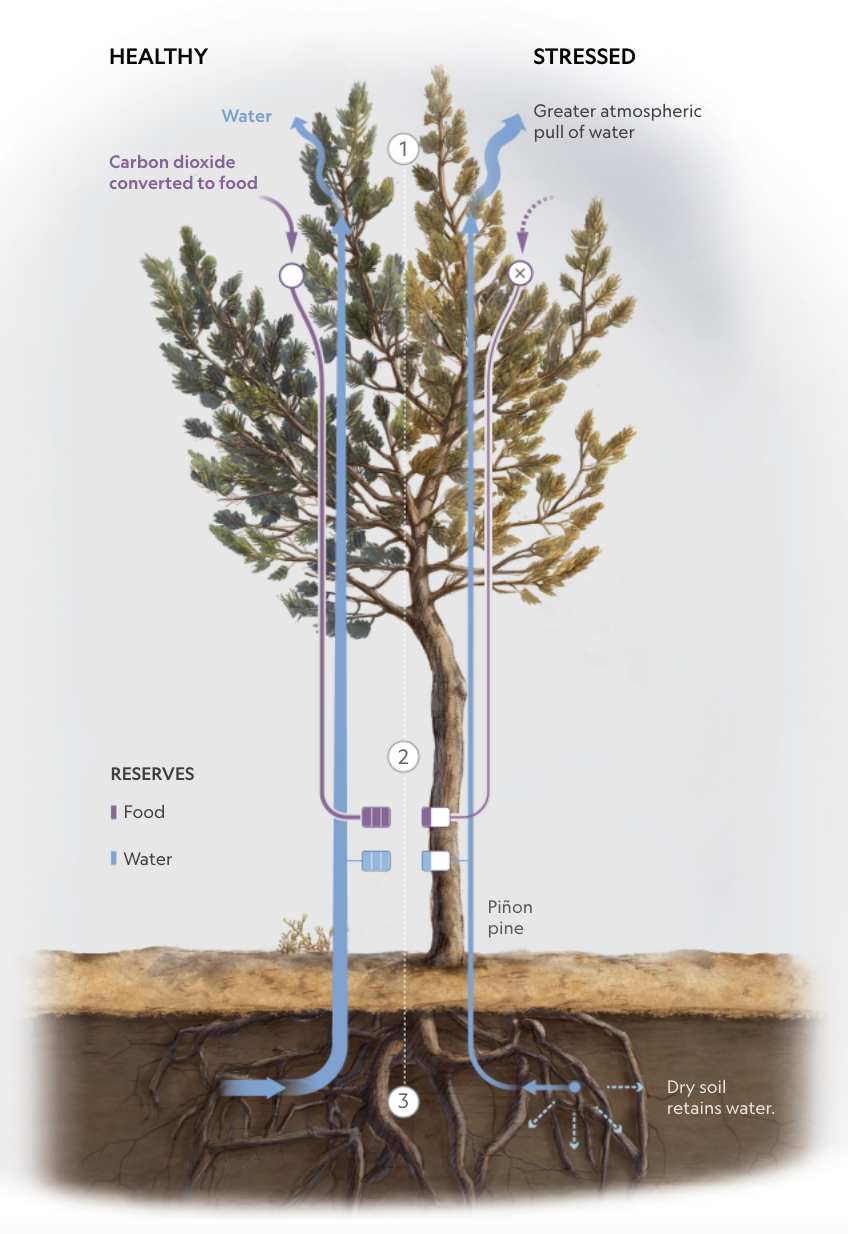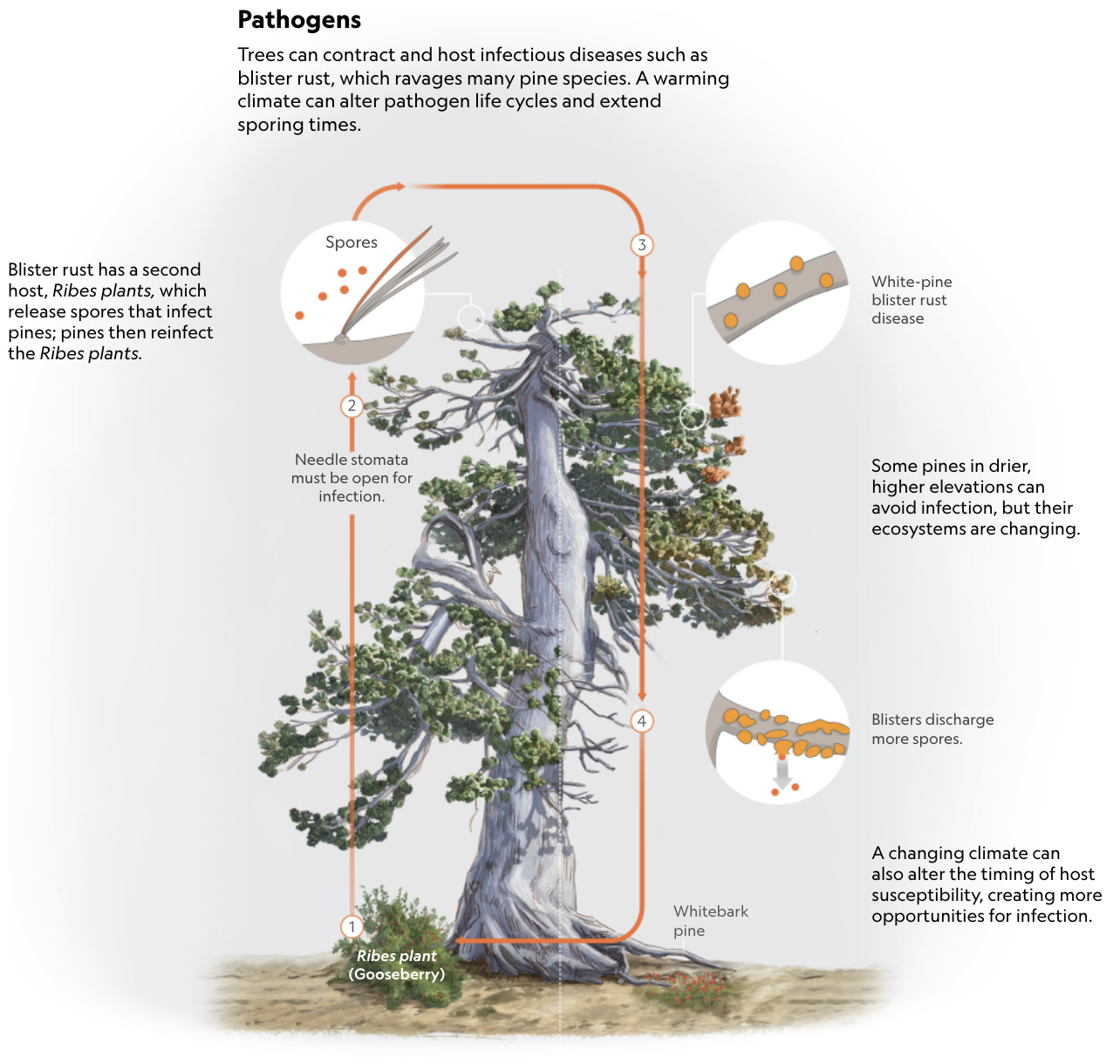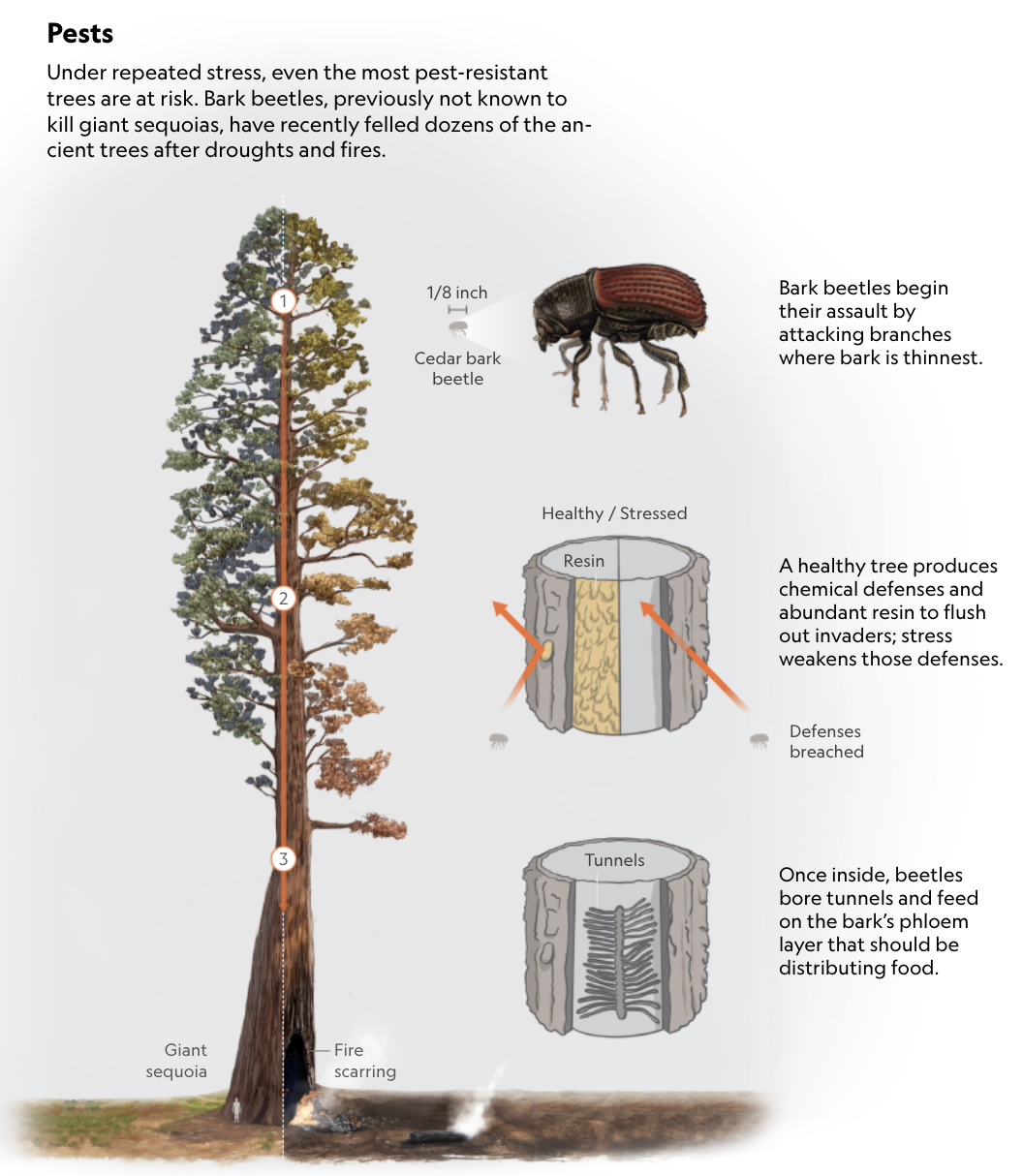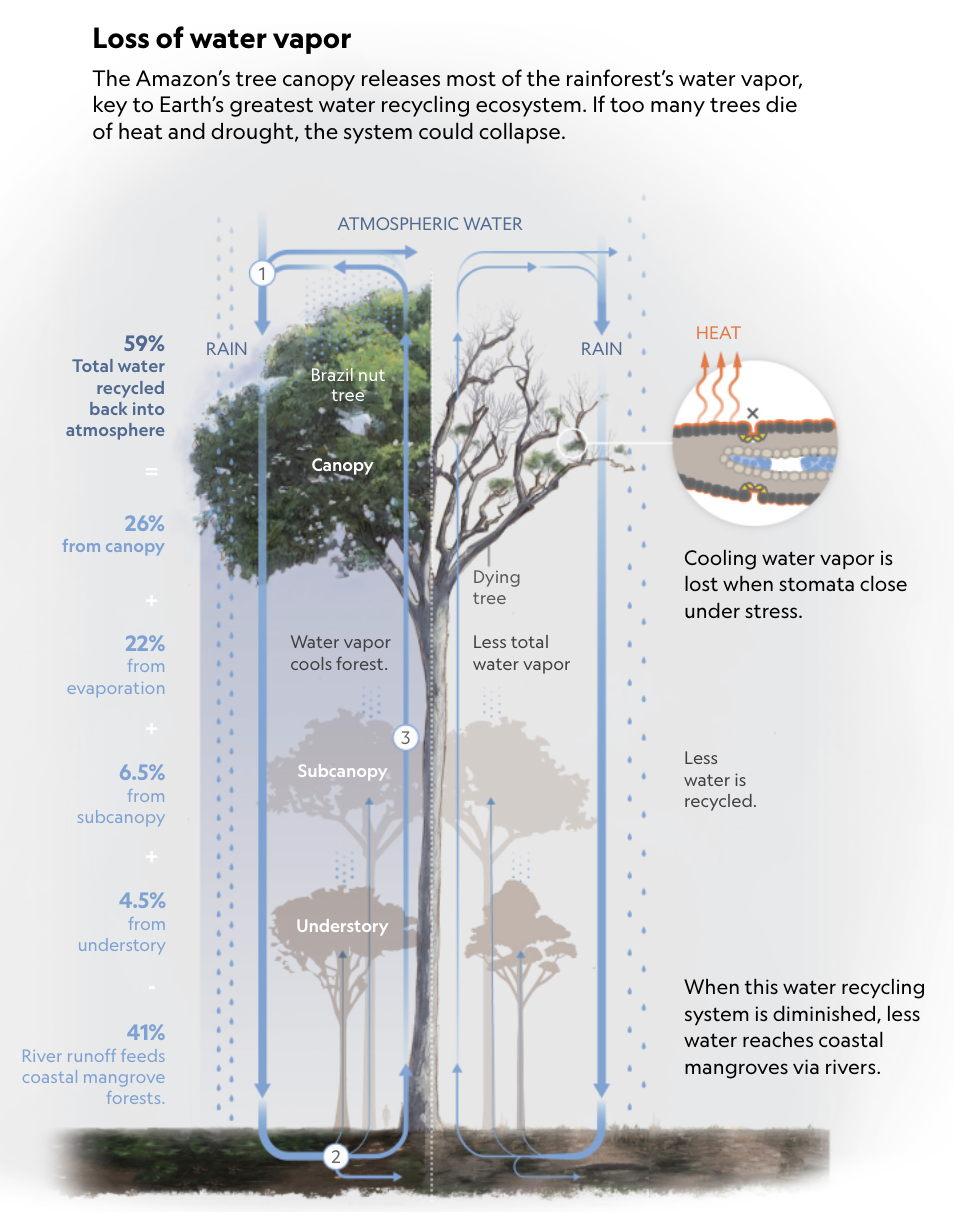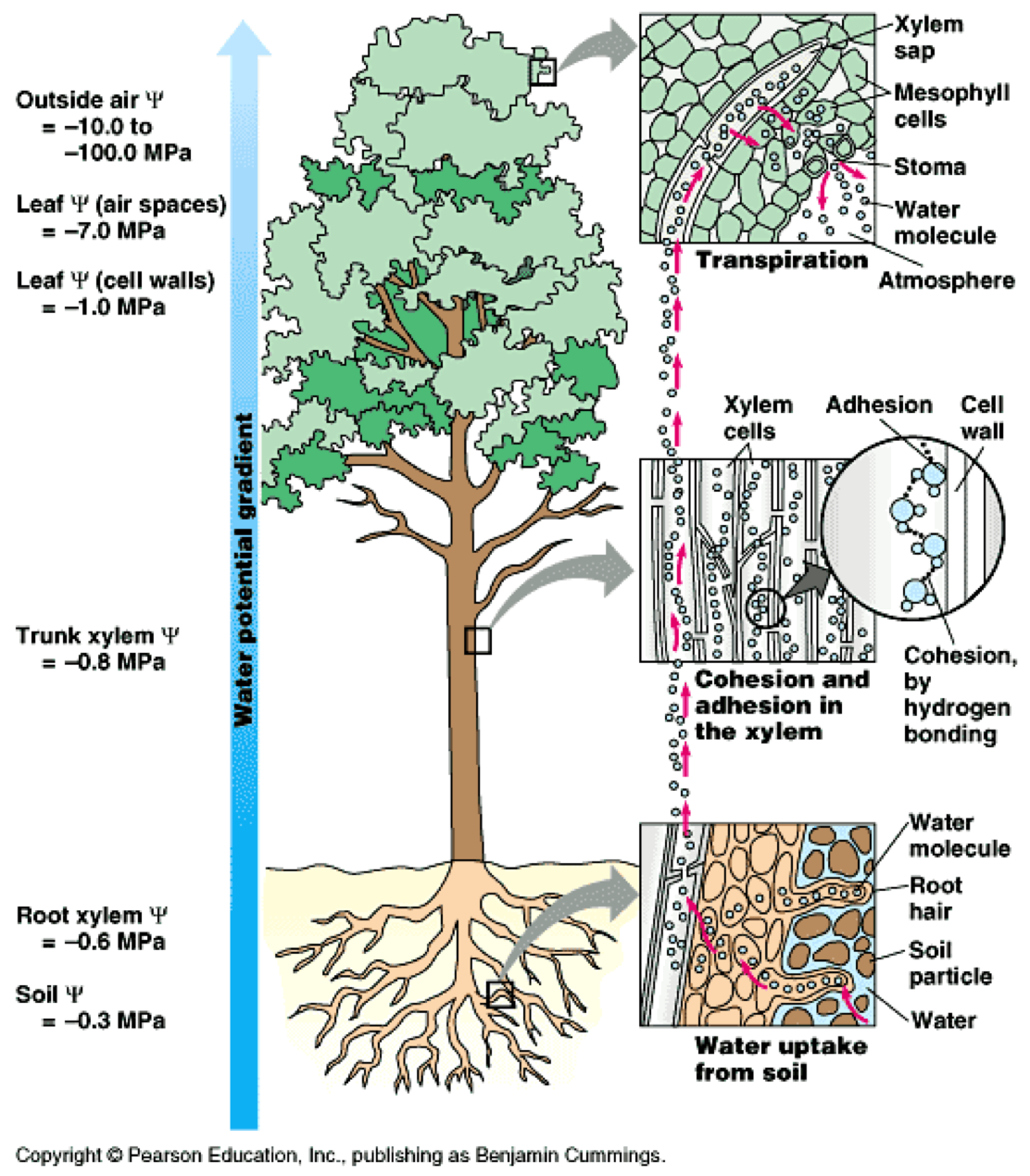The Hidden Life of Trees by Wohlleben
Ref: Peter Wohlleben (2016). The Hidden Life of Trees. What They Feel, How They Communicate. Allen Lane.
____________________________________________________________________________
Summary
Together, many trees create an ecosystem that moderates extremes of heat and cold, stores a great deal of water, and generates a great deal of humidity. And in this protected environment, trees can live to be very old.
When trees grow together, nutrients and water can be optimally divided among them all so that each tree can grow into the best tree it can be. If you “help” individual trees by getting rid of their supposed competition, the remaining trees are bereft.
We are part of Nature, and we are made in such a way that we can survive only with the help of organic substances from other species. We share this necessity with all other animals. The real question is whether we help ourselves only to what we need from the forest ecosystem, and—analogous to our treatment of animals—whether we spare the trees unnecessary suffering when we do this.
Wood Wide Web (aka Mycorrhizal Network): Communication and exchange of resources such as water, sugar, N, C, and other nutrients and minerals amongst forest trees, including those of different species, through dense underground fungal networks, that operate like fiber-optic internet cables termed ‘hyphae’. A single fungus can cover many sqmi and network an entire forest. Signals travels at the slow speed of a 1/3" per min.
____________________________________________________________________________
Trees
Trees: Convert light, CO2, and H2O into supplies of sugar, cellulose, and other carbs.
Roots:
Lateral: Extend laterally through the soil on average more than 2x the spread of the crown.
Depth: Few species grow deeper than 1.5m and most halt downwards growth much sooner.
Growth: Trees grow only from the tip; at maximum height (where exertion of the trees vascular system is too much to pump water upwards), the tree begins widening.
Cambium: The actively growing layer between the bark and the wood; succulent and stuffed full of sugar and minerals, this is where the trunk grows as wood cells form on the inside and bark cells form on the outside.
Expiration: (In summer), release ~29t of O2 into the air per sqmi of forest (A person breathes in nearly 2lbs of O2 a day, so that’s the daily requirement for ~10K people).
Energy: Trees use most their energy for daily living- digesting food, ‘breathing’, supplying fungal allies with sugar, and growing. Afterwards, the tree used excess to fight off pests. Trees use the last of their energy to produce blossoms of which most of the sugar is converted into oil and starch in the seeds.
Water: To produce 1lb of wood, the average tree requires ~36gal H20. Some, like Beeches need only 22gal of water, enabling them to shoot up more quickly. A mature beech tree can send more than 130gal of water a day coursing through its branches and leaves.
Capillary Action: The ascension of a liquid through a thin tube, cylinder, or permeable susbstance due to adhesion and cohesion. The narrower the vessel, the higher the liquid can rise against gravity. And the vessels that transport water in deciduous trees are very narrow indeed: they measure barely 0.02” across. Conifers restrict the diameter of their vessels even more, to 0.0008”. In even the narrowest of vessels, there is only enough force to account for a rise of 3 feet at most.
Transpiration: Evaporation of H2O vapor by trees; upwards of 8500 cubic yards of water per sqmi of forest. Transpiration creates new clouds that travel farther inland to release their rain. As the cycle continues, water reaches even the most remote areas. This water pump works so well that the downpours in the Amazon Basin, are almost as heavy thousands of miles inland as they are on the coast.
In the warmer part of the year, leaves and needles transpire by steadily breathing out water vapor. In the case of a mature beech, the tree exhales hundreds of gallons of water a day. This exhalation causes suction, which pulls a constant supply of water up through the transportation pathways in the tree.
Carbon Storage: As trees photosynthesize, they produce hydrocarbons, which fuel their growth, and over the course of their lives, they store up to 22 tons of CO2 in their trunks, branches, and root systems. When they die, the same exact quantity of GHG is released as fungi and bacteria break down the wood, process the CO2, and breathe it out again.
The crumbling trunk is gradually gnawed and munched into smaller and smaller pieces and worked, by fractions of inches, more deeply into the soil. The rain takes care of whatever is left, as it flushes organic remnants down into the soil. The farther underground, the cooler it is. And as the temperature falls, life slows down, until it comes almost to a standstill. And so it is that CO2 finds its final resting place in the form of humus, which continues to become more concentrated as it ages. In the far distant future, it might even become bituminous or anthracite coal. Over the course of thousands of years, they turned into thick layers of peat that are then overlain with rocky debris, and pressure gradually turns the peat to coal. Large conventional power plants today are burning fossil forests.
Death: Every tree gradually stops growing taller and instead, widens. At first, it can no longer manage to feed its topmost twigs, and these die off. Once all the topmost twigs and small branches are lost, only the thicker lower branches remain. Eventually, they die too, though they are not so easily dislodged. Now the tree can no longer hide its advanced age or its infirmity. It’s at this time, if not before, that the bark comes into play once again. Small moist wounds have become portals for fungi to enter. The fungi advertise their triumphant advance through the tree by displaying magnificent fruiting bodies that jut out from the trunk in the shape of semicircular saucers that grow larger with each passing year. Inside, the fungi break down all barriers and penetrate deep into the wood at the heart of the tree. There, depending on the species, they consume stored sugar compounds or, even worse, cellulose and lignin, thereby decomposing the tree’s skeleton and reducing it to powder, even though the tree has been bravely resisting this process for decades. On either side of the wounds, which continue to expand, the tree grows new wood, which it builds up into thick stabilizing ridges. For a while, that helps to shore up the ruined structure against powerful winter storms. Then one day, it’s all over. The trunk snaps and the tree’s life is at an end. In total, a fifth of all animal and plant species, ~6K species depend on dead wood.
Seeds: Register temperature and fruit only after extended warm periods followed by hard frost. Statistically speaking, each tree raises exactly one adult offspring to take its place.
Every five years, a beech tree produces at least 30K beechnuts (thanks to climate change, it now does this as often as every two or three years, but we’ll put that aside for the moment). It is sexually mature at ~80-150 years of age, depending on how much light it gets where it’s growing. Assuming it grows to be 400y old, it can fruit at least 60x and produce a total of about 1.8M beechnuts. From these, exactly one will develop into a full-grown tree.
Leaves
For every square yard of forest, 27 square yards of leaves and needles blanket the crowns.
Anthocyanin: A type of UV blocking sunscreen produced by leaves that tinge them with a red coloring to protect their delicate tissues. As the leaves grow, the anthocyanin is broken down with the help of an enzyme (although some trees, like beeches and maples retain the anthocyanin, remaining red).
The removal of chlorophyl turns leaves yellow, orange, and red.
Trees register shorter days and falling temperatures and use this information to decide when to drop their leaves before the first heavy snowfall.
Defense: Trees produce various chemical combinations to ward off pests including tannins and acids, emit gases to alert other trees, and release pheromones that summon specific beneficial predators.
The saliva of insect species is different and trees can match the saliva to the insect. Indeed, the match can be so precise that trees can release pheromones that summon specific beneficial predators.
____________________________________________________________________________
Conifers
Conifers: Trees and shrubs that produce cones and have leaves resembling needs or scales in shape.
Emit terpenes, substances intended as a defense against illness and pests that mix with water vapor in the air creating clouds that are twice as thick as the clouds over non-forested areas.
To minimize water loss during winter, conifers cover the exterior of their needles with a thick layer of wax.
Spruce Trees: Store essential oils in their needles and bark, which act like antifreeze in the winter enabling them to keep their needles in the cold season.
____________________________________________________________________________
Deciduous
Deciduous (‘to fall off’): Trees and Shrubs that seasonally shed leaves; include oaks, maples, beeches. By discarding their leaves, trees avoid winter storms that would otherwise topple them.
Oak Trees: Oak wood is permeated with tannins- toxic and bitter tasting substances that discourage fungi, severely slow down fungal decomposition, and scare off insects.
Acacia Trees: When eaten, emit ethylene as a warning gas that signals neighboring trees of the same species.
Willow Trees: Willows produce the defensive compound salicylic acid (an aspirin precursor), which works similar to tannins. Tea made from willow bark can relieve headaches and bring down fevers.
____________________________________________________________________________
Climate Change
Land Change
Trees produce seeds more often.
In Central Europe, there are no longer any true old-growth forests. The largest extensive stand of trees is between 200-300 years old.
Most national parks sell to sawmills the trees they have felled and removed from the forest to combat bark beetle infestations. This is a grave mistake. For the dead spruce and pines are midwives to the new deciduous forest. They store water in their dead trunks, which help cool the hot summer air to a bearable temperature. When they fall over, the impenetrable barricade of trunks acts as a natural fence through which no deer can pass. Protected in this way, the small oaks, bird cherries, and beeches can grow up unbrowsed. And when one day the dead conifers rot, they create valuable humus.
A severely pruned crown is a severe blow for the roots, which grow to a size optimally suited to serve the above-ground parts of the tree. If a large percentage of the branches are removed and the level of photosynthesis drops, then just as large a percentage of the underground part of the tree starves. Fungi now penetrate the dead ends where branches have been removed and the trunk has been sawn off. The wood is filled with air pockets, thanks to the tree’s quick growth as a youngster, and fungi have a field day. After only a few decades—which is incredibly fast for a tree—this inner rot can also be seen on the outside of the tree.
Loner trees, like those found in cities and parks, may look healthy, but they have no idea what is going on around them.
Trees transfer life-giving moisture into land-locked interiors. The whole process breaks down if coastal forests are cleared.
____________________________________________________________________________
Terminology
Ancient Woodlands (aka Old-Growth Forests, forest reserves): A designation used to protect forests from deforestation.
CaCO3: Excreted by Coral; one of the largest repositories of CO2 on Earth.
Foam Pools: Form after heavy rains; the result of humic acids from the decomposition of leaves and dead wood that tiny waterfalls mix with the air until they turn to froth; extremely beneficial for the ecosystem.
Fungi: Somewhere between animals and plants with cell walls made of chitin (found in insects but not plants). Unable to photosynthesize and depend on organic connections with other living things to feed on. In exchange for sugar, fungi filter out heavy metals turning them into porcini, cèpe, or bolete mushrooms.
Honeydew: Aphid excrement; ingested by honeybees and regurgitated at their hives, where they are turned into dark forest honey.
Lichen: Small gray-green growths; a symbiotic combination of fungi and algae.
Algal Blooms: Blue-green algae that capture N from the air and process it into a form the trees can use. Rain then washes this natural fertilizer down the trunks, making it available to the roots.
Osmosis: Flow of water through a membrane from high to low concentration.
____________________________________________________________________________
Misc Quotes
“…Account [is] to be taken of the dignity of creation when handling animals, plants and other organisms.”-Swiss Constitution.
Algal activity in the oceans balances the O deficit in winter so well that we can breathe deeply even when we are standing under beeches and spruce covered in snow.
Soil organisms generate so much heat that even in a hard frost, the ground doesn’t freeze down more than 2”.
____________________________________________________________________________
Chronology
2009: Dr. Martin Gossner spray a 170’ tall, 6’ wide, 600y old tree in the Bavarian Forest National Park with the insecticide pyrethrum, counting 2041 animals belonging to 257 different species.-Trees by Wohlleben.
1997: “The Wood Wide Web” is published in ‘Nature’ magazine demonstrating how trees communicate and exchange resources such as water and sugar in forests, including with those of different species, through dense underground fungal networks.-Trees by Wohlleben.
Carboniferous Period: CO2 levels are ~9x that of today’s levels before prehistoric forests, among other factors, reduce CO2 to a level still triple the concentration we have today.-Trees by Wohlleben.
____________________________________________________________________________
